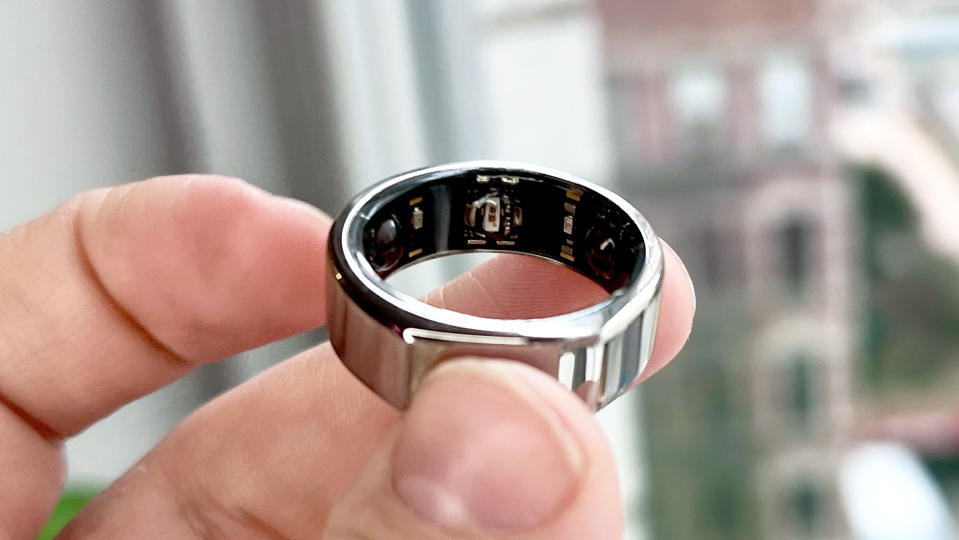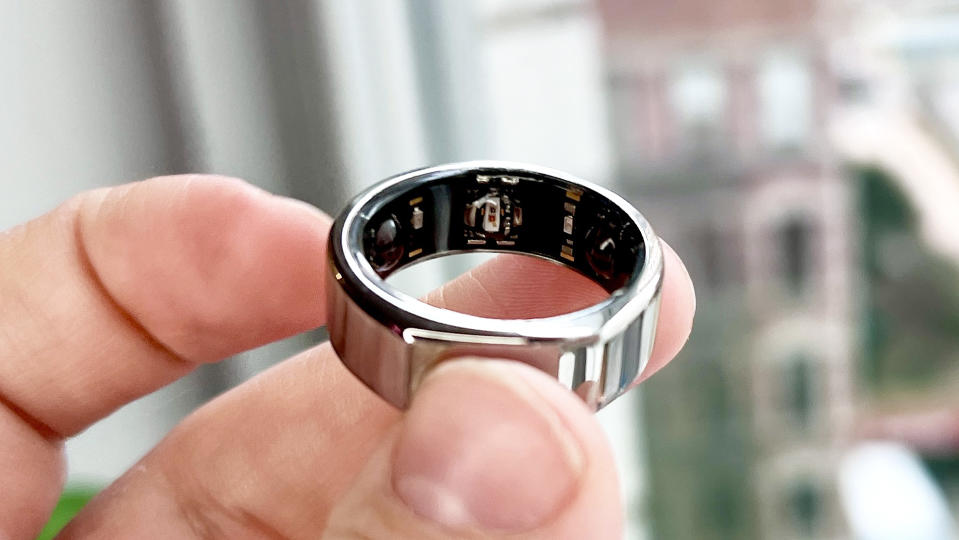Samsung Galaxy Ring vs. Oura Ring — which smart ring wins?
When you buy through links on our articles, Future and its syndication partners may earn a commission.

If you're looking to invest in one of the best smart rings, the inevitable question comes up; the Oura Ring Gen 3 or the Samsung Galaxy Ring?
After months of teasing, Samsung debuted its ring in July 2024. Meanwhile, the Oura Ring is a more mature product in its third generation, which launched in late 2021 (although we think the Oura Ring 4 may be on the way soon).
The third-generation Oura Ring is one of the best fitness trackers available right now. It comes in several finishes and can track your sleep, and measure your heart rate, respiratory rate and body temperature.
The Samsung Galaxy Ring similarly is available in several finishes and keeps tabs on a range of wellness indicators; it also contextualizes your data with actionable tasks and insights backed by AI.
Which one is better? That depends; here's a breakdown of the Samsung Galaxy Ring vs. Oura Ring based on factors like cost, design, features, battery life and compatibility.
Samsung Galaxy Ring vs Oura Ring: price

The Samsung Galaxy Ring retails for $399, which makes it more expensive than the Samsung Galaxy Watch 7 ($299). This feels a lot, especially when the Oura Ring retails for $299. But to use the Oura Ring, you need an Oura Membership for $5.99 per month to get personalized insights and live heart rate tracking.
Meanwhile, there is no subscription or membership charge for the Galaxy Ring; once you own the ring, all the features are free to use. The data syncs via Bluetooth to the Samsung Health app on your Samsung phone, where the recordings are analyzed.
Of course, Samsung may one day decide to take the Fitbit route and launch a service like Fitbit Premium inside Samsung Health. In that case, there may be some limited data viewable in the app for free, but you’d need a subscription for detailed analysis and recommendations, though there's no indication of this at the moment.
Samsung Galaxy Ring vs Oura Ring: design

Unsurprisingly, the Samsung Galaxy Ring looks like..a ring. It's slightly wider and thicker than a standard ring but is similar to the Oura Ring 3. This wasn't unexpected, as we saw the Galaxy Ring at MWC in February, where the company locked a few of the smart rings in several colors in a glass box.
It comes in three colors — Black, Gold, and Silver — so you do have some degree of personalization. Meanwhile, the Oura Ring is available in Silver, Black, Gold, and Stealth, so Samsung may be taking design cues from Oura here.
The Oura Ring is extremely comfortable to wear all day, and it's lightweight enough that you can pop it on and forget about it. While reviewing the Oura Ring, we even accidentally tested out the ring’s waterproofing after it fell into the laundry and emerged unscathed.
The Galaxy Ring is similarly comfortable and lightweight. It's also IP68-rated for water resistance and should survive immersion in 1.5m for up to 30 minutes, making it safe for showers, workouts, and daily use. It's helpful both brands took this approach, as it would be a pain if you had to take it off every time you cleaned your hands, washed the dishes, or did a sweaty workout.
Samsung Galaxy Ring vs Oura Ring: features

The first-generation Oura Ring was more like a fitness tracker without a display, but the latest edition takes a more holistic approach, designed to help you monitor your activity, but also how you feel physically and mentally using 20 biometric signals captured by its various sensors.
So, like the best Fitbits, you can track your steps, calorie burn, and overall activity levels. However, it doesn’t support workout tracking, so you either need a separate smartwatch or fitness tracker, or log your sessions in Apple Health or Google Fit and sync them to the Oura app.
The Galaxy Ring also covers the fitness tracking essentials, like step counting, heart rate monitoring, and sleep tracking. Most wearables also now offer some degree of female health tracking and cycle monitoring, and that's also the case with the Galaxy Ring, which offers period tracking and prediction.
This helps it compete with the Oura Ring, which integrates with the birth control app Natural Cycles, to track your menstrual cycle. The ring measures your temperature in the morning, and syncs that to Natural Cycles to inform your daily fertility status.
It’s impressively accurate, as our fitness editor found that the Oura Ring actually saw signs of her pregnancy before she did. Samsung has a similar partnership with Natural Cycles on some of its Galaxy smartwatches, including the Samsung Galaxy Watch 6, but the Ring's implementation is slightly different.
For Oura's version, you need an Oura membership and a Natural Cycles subscription (for $20 per month), but you get full access to Natural Cycle's fertility, period tracking, and contraceptive features. Meanwhile, Samsung's edition is subscription-free.
But it's not all good news, as Samsung has only added a limited version of Natural Cycle's tech to the Samsung Health app, so you can track and monitor your periods, but you can't use the full array of pregnancy and fertility planning features.
As the competition between the two brands heats up, Oura has continued adding features to its existing models, like the Cardiovascular Age and Cardio Capacity heart health monitoring rolled out in May 2024. Plus, Oura launched Labs, so you can try new features before they're ready for the masses, along with a new AI Advisor.
Samsung Galaxy Ring vs Oura Ring: battery life
Despite the small size of both trackers, battery life is impressive. The Oura Ring Gen 3 can go up to a week, although we found it is closer to five days in practice. The Galaxy Ring can also last for up to week but six days is a more reasonable expectation.
Samsung Galaxy Ring vs Oura Ring: compatibility

The Oura Ring is designed to work with iPhones and Android smartphones, but the Samsung Galaxy Ring will likely take a different approach. Samsung has been very clear that it intends to build a Galaxy ecosystem around the Health app.
In that sense, they’re following in Apple’s footsteps — you’ll buy a Samsung Galaxy smartphone, wear a Galaxy Watch 7 or Watch Ultra for workouts, and track your overall activity and sleep using the Galaxy Ring, with all the data easily accessible in the Samsung Health app.
So, while the design of the Galaxy Ring definitely positions it as an Oura Ring competitor, Samsung sees it as a way to passively gather data that you can use as part of the wider Galaxy ecosystem to improve your health and well-being, rather than a standalone device like the Oura.
And, according to a post in the Samsung Newsroom, the company hopes to use AI-powered insights to give actionable recommendations in the Samsung Health app, like the new My Vitality Score, based on the data gathered by your various Samsung devices, which also suggests an ecosystem-style approach.
Samsung also seems to be giving all of its products an AI-focused makeover, as there are several AI health and fitness features on the new Galaxy watches, lending support to the idea that you wear the watch and ring in tandem.
Samsung Galaxy Ring vs Oura Ring — which comes out on top?
The choice between the Oura Ring Gen 3 or the Samsung Galaxy Ring will likely be dictated by which type of phone you have. For owners of Samsung phones, the decision is obvious. Also clear is the fact that Samsung is emulating Apple’s approach and creating a seamless ecosystem of gadgets, data, and software.
So, if you’re a fan of the ring form factor to keep tabs on your health and well-being but use an iPhone or other Android device, the Oura Ring is the better option. However, the Oura Ring’s true cost is higher than its $299 price tag.
To get the most from the wearable, you’ll also need to take out the $5.99/month membership to get access to personalized insights, which is a feature that may be available free of charge in the Samsung Health app.
However, if you're after a non-Oura ring and the Galaxy Ring isn't right for you, then the Amazfit Helio Ring may be worth a look. Not only does it play nicely with Apple and Android smartphones, but it also doesn't require a monthly subscription to use.
